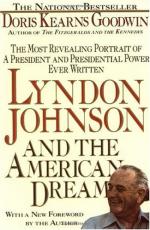
|
| Name: _________________________ | Period: ___________________ |
This test consists of 15 multiple choice questions and 5 short answer questions.
Multiple Choice Questions
1. Where is the Mekong river?
(a) Tennessee.
(b) China.
(c) Japan.
(d) Vietnam.
2. What did the elder statesman Averell Harriman observe about Johnson in the beginning of "Vietnam"?
(a) He will be remembered as a great president.
(b) He is in over his head.
(c) He will be remembered as a poor president.
(d) He didn't do enough.
3. In June 1965, what was Johnson insisting upon about America's involvement in Vietnam?
(a) The U.S. was not at war.
(b) The U.S. was fully in the war and needed public support.
(c) The U.S. had never done bomb strikes in Vietnam.
(d) He was not a supporter of the war.
4. Who did Johnson appoint to the Supreme Court that he thought mothers would name their newborn sons after?
(a) William Brennan.
(b) Thurgood Marshall.
(c) Earl Warren.
(d) Warren Burger.
5. What did President Nixon do to Johnson's Great Society programs?
(a) Refined them.
(b) Supported them all.
(c) Gave them more funding.
(d) Ended many of them.
6. Who did Johnson think would want to end the war quickly through total annihilation?
(a) Defense Secretary.
(b) CIA.
(c) Conservatives in Congress.
(d) Generals.
7. What Vietnamese people did Johnson want to help in the Vietnam War?
(a) South Vietnamese.
(b) Communists of Hanoi.
(c) Viet Cong.
(d) North Vietnamese.
8. Who was Eugene McCarthy?
(a) Democratic Senator who opposed Johnson in the primaries.
(b) White House Aid.
(c) Singer.
(d) Author.
9. What did Johnson take control of with each department during his first elected term as President?
(a) Cultural events.
(b) Dress code.
(c) Restaurant choices.
(d) Budget and staffing.
10. In "The Withdrawal," why did Johnson withdraw to the White House?
(a) Fear of Robert Kennedy.
(b) To plot his re-election campaign.
(c) To create a plan to win the war.
(d) Criticism over his policies and faltering Great Society programs.
11. What political figure was assassinated in 1968?
(a) Eugene McCarthy.
(b) Robert Kennedy.
(c) Hupert Humphrey.
(d) John Kennedy.
12. Who was Governor of the state in which King organized a march in 1965?
(a) Johnson.
(b) Fulbright.
(c) Wallace.
(d) Smith.
13. What did Johnson decide to do on March 31, 1968?
(a) Change his entire cabinet.
(b) Send new legislation on Medicare to Congress.
(c) De-escalate the war and withdraw from politics.
(d) Re-energize the Great Society program.
14. In "Vietnam," what does the author say that Johnson wanted to set up in Vietnam after suppressing the war?
(a) Think tank.
(b) Environmental conference.
(c) Democracy.
(d) World leaders meeting.
15. What was the public's reaction to Robert Kennedy during his 1968 campaign for President that Johnson did not like?
(a) Angry.
(b) Lukewarm
(c) Enthusiastic.
(d) Hostile.
Short Answer Questions
1. What did Johnson ask each member of Kennedy's cabinet after Kennedy's assassination?
2. In 1968, what was the number of casualties in the Vietnam war?
3. Who was inaugurated on January 20, 1969?
4. Where did Martin Luther King, Jr. organize a march in 1965?
5. What did the North Vietnamese do during the Tet offensive?
|
This section contains 514 words (approx. 2 pages at 300 words per page) |

|




